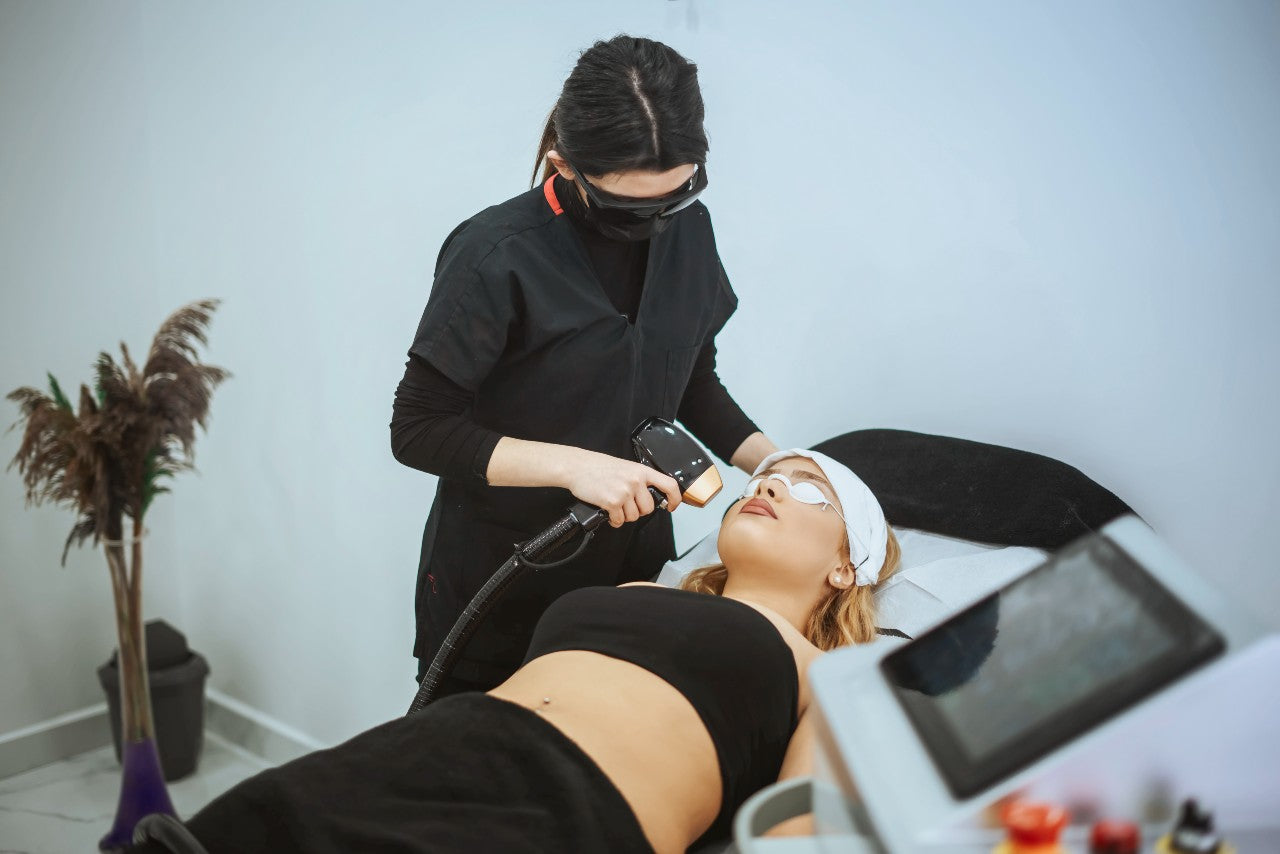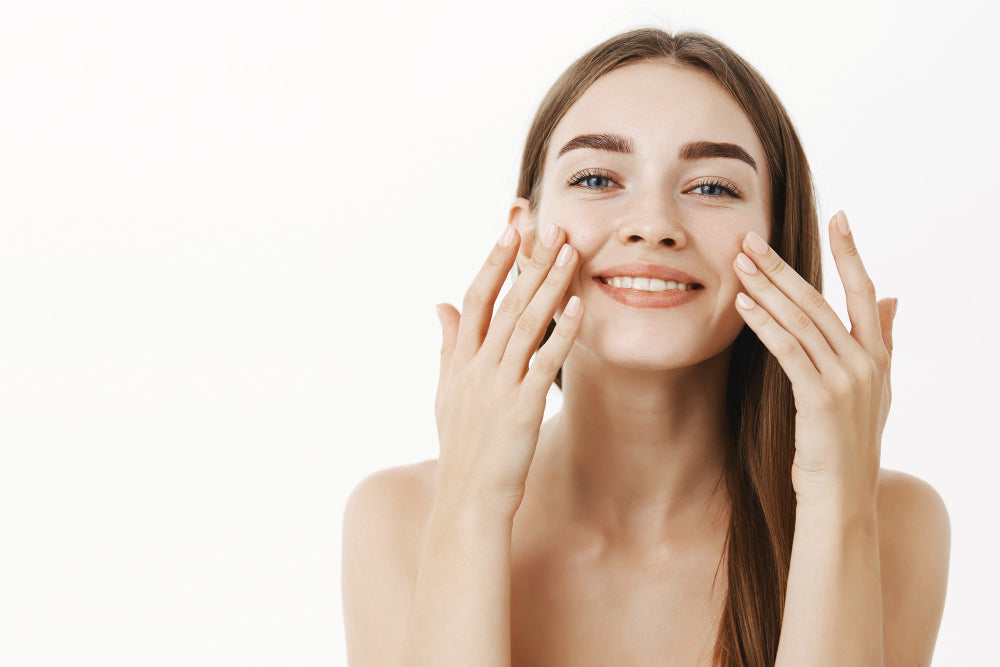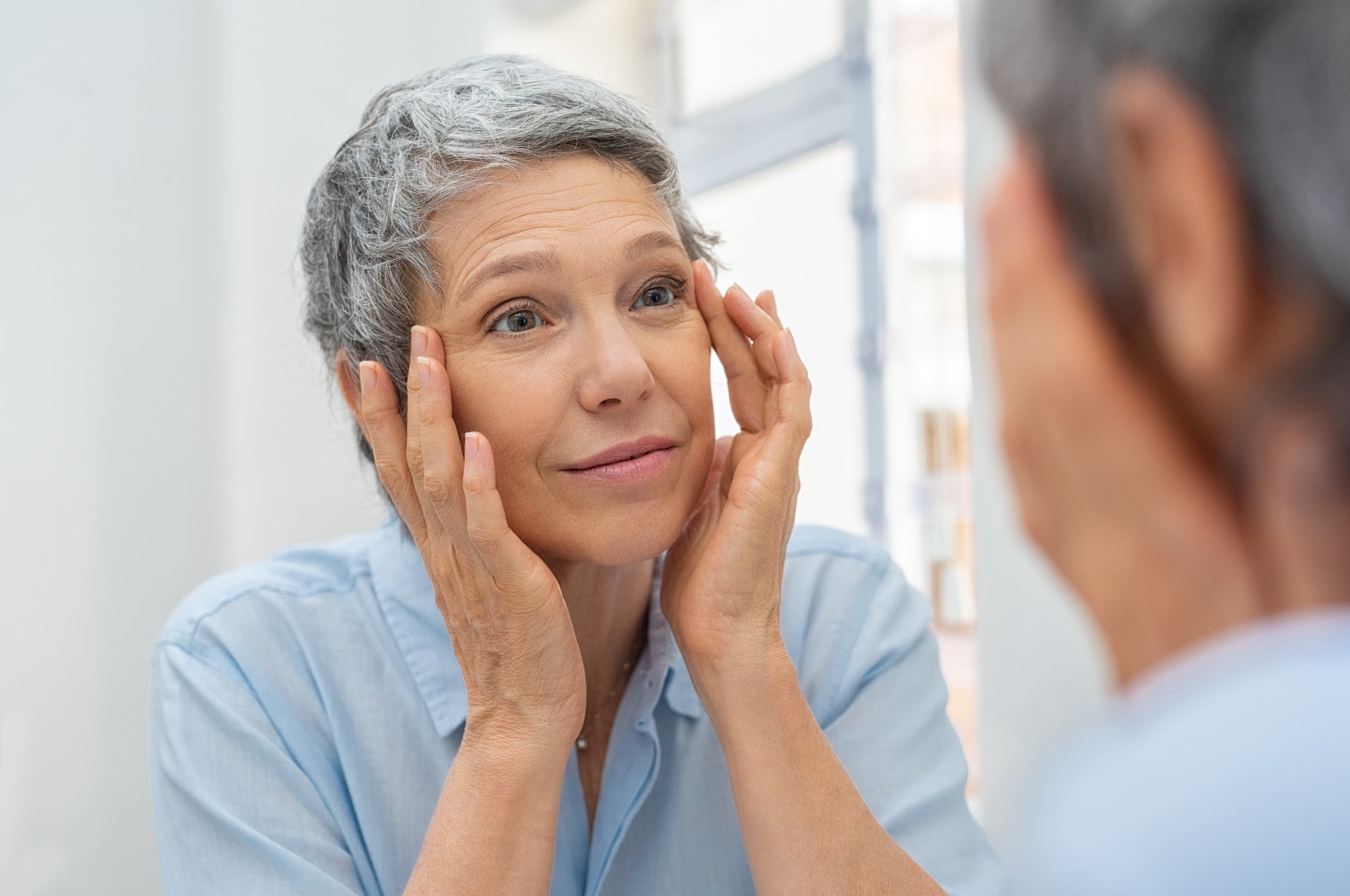Medically Reviewed by Dr. Lisa Hartford, MD
Embraced by many as signs of maturity and wisdom, forehead wrinkles are an eyesore for those wanting to preserve their youthful appearance. While completely harmless from a biological standpoint, they are often seen as undesirable, and to many, a reminder of how they’re getting older with every passing year and with newer ones showing up, while existing ones appear deeper. They profoundly influence our self-esteem, self-perception and idea of our level of attractiveness. When asked, most individuals, while not denial about the natural aging process, will nevertheless share that if they can engage in routines or therapies that promise to lessen the appearance of forehead wrinkles or the sagging jowls, that they would be willing to do so in order to showcase the best version of themselves at that age, first to themselves, and then to the world around them, i.e. that aging naturally with a bit of upkeep in the form of nutrition, rest, supplement, and where appropriate and desired, more involved intervention such as nonsurgical and surgical options. In this article we embark on a comprehensive scientific journey, delving into DIY techniques that offer promising avenues for rapid wrinkle repair. By deciphering the underlying mechanisms and harnessing the power of natural regenerative processes, we discuss advanced technologies such as radiofrequency (RF) and ultrasound, along with uncovering holistic strategies that also help combat and address forehead wrinkles effectively.
The Anatomy of Forehead Wrinkles: How they’re formed
It’s quite simple really. Skin’s elasticity, also referred to as laxity, is reduced as we age. This takes place due to depletion of collagen and elastin proteins that form a significant amount of scaffolding and support for our topical skin. Our body’s programming that leads to a reduced amount of these proteins being formed as we age causes the replenishment of them to not be able to keep up with the rate of loss. This shows up in the form of excess skin, and the ridges that form in said skin all over are known as wrinkles, and our forehead is no exception.
Collagen & Elastin: Their Specific Roles in the Ensuring A More Youthful Appearance
Collagen, skin’s foundational protein, forms its scaffolding support structure, while elastin confers the ability on our skin to be better able to bounce back from a physically-depressed state. With the passage of time, however, as alluded to above, our cellular transcription machinery and processes such as defective mechanical stimulation and fibroblast aging triggers a slowdown in collagen production and a decline in elastin's effectiveness. This, being a global process, causes skin to sag or loosen, and is the same exact process in most areas of our body, and is also responsible for the formation of forehead wrinkles.
Scientific Research On The Critical Role of Collagen & Elastin
A multitude of scientific literature and studies have gone on to study the importance of, and critical role played by, collagen and elastin, in the aging process. Studies have indeed established that decreased collagen levels contribute to sagging skin and the development of fine lines and wrinkles. For example, a study by Knuutinen et al. (2002) published in the Skin Research and Technology journal explored the relationship between collagen and our skin's aging process. It revealed that collagen played a significant role in maintaining the skin's elasticity and firmness. Knuutinen et al. highlight the importance of collagen synthesis and maintenance for preventing the visible signs of aging. The study underscores how decreased collagen levels are linked to the development of wrinkles and the loss of skin resilience & elasticity. (Knuutinen et al., Skin Research and Technology, 2002). Similarly, in relation to Elastin, the other critical protein responsible for aging, a study conducted by Uitto et al., and published in the Journal of Investigative Dermatology in 1986 found that as individuals age, there is a reduction in the presence and effectiveness of elastin in the skin which contributes to the loss of skin's ability to stretch and recoil, leading to decreased skin elasticity and increased propensity for wrinkle formation.
Innate Genetic Programming or Effective Skin Care: Which Help More to Lessen Wrinkle Formation?
The timeline for the emergence of wrinkles, as well as the way they appear on one’s skin, along with how many wrinkles one may develop versus their counterparts, is an intricate interplay between one’s genetic makeup, something that’s considered innate, or that which we’re born with, and with our lifestyle choices, something we all choose to a great degree and can proactively adapt in whichever direction we so choose. Intrinsic or genetically-determined factors, being primarily governed by our genes, lay the foundation for how our skin ages, when it starts to sag, and how noticeable the wrinkles may be, among other skin properties. The latter, being better explained as extrinsic or environmental factors, in contrast, encompass influences and habits we cultivate and embrace along our lives that we exercise choice and control over.
Genes, being the architects of our skin's destiny, play a very significant role in determining its propensity for aging. Genetic variations can impact collagen production & synthesis, antioxidant defense thresholds, and the efficiency of natural built-in repair mechanisms of our bodies, influencing the skin's vulnerability to wrinkles (Schagen et al., Dermato-Endocrinology, 2012). These genetic factors contribute, in great part, to the overall skin aging process and the development of wrinkles (Dunn et al., Experimental Dermatology, 2018).
As alluded to above, extrinsic factors also wield considerable power on our external aging appearance. The sun, for example, while generally considered a source of vitality, can also be a catalyst for aging, whereby Ultraviolet (UV) radiation that generates oxidative stress, can result in the production of havoc-causing free radicals that damage the skin's architecture and intricate natural framework, something that gets harder to fix and repair as we age.
A number of deeper scientific investigations have also solidified the link between UV exposure and skin aging to discriminatively show that UV radiation contributes to collagen degradation. Collagen degradation, being a pivotal factor in wrinkle formation (Fisher et al., Journal of Investigative Dermatology, 2002) should thus be avoided through lifestyle choices such as use of sunscreen and the avoidance of prolonged sun exposure. It must be further noted, that while research is ongoing on this subject, the impact of UV radiation also includes DNA damage which can lead to uncontrolled cell growth, leading to unhealthy aging-promoting scenarios such as cancerous tissue development and cause lessened ability of our skin to self-repair sun damage. (Young et al., Journal of Dermatological Science, 1995).
Nurturing & Rejuvenating Skin Health Through DIY Techniques
When it comes to helping one’s skin look younger, while it pays to understand one’s genetic makeup and the limitations and benefits it may confer upon your skin, understanding the remedies out there to increase the ‘youth’ factor of one's skin, and how to regularly employ such remedies, many of them being natural, can go a long way in informing the creation of healthy habit and routines to help manage one’s skin in relation to their appearance expectations. Options abound, many such remedies include antioxidant-rich diets, topical skin care application and facial massages on the lower end, while other more involved ones such as at-home devices and in-clinic skin firming treatments which require more time and monetary investments.
Antioxidants & How They Help Maintain Youthful Skin
A diet rich in antioxidants is by far one of the easiest and most practical modifications/additions to one’s diet that can pay significant dividends in the fight against wrinkles. These micronutrients, found in abundance in specific foods, wage war against free radicals. Thus, antioxidants help neutralize the culprits behind oxidative stress in an almost automatic manner, the only requirement being that one consumes food rich in these vital helpers. Notable, Vitamins A, C, and E, along with minerals like Selenium, are well known antioxidants that serve as the skin's protective shield against oxidative damage.
Clinical studies have recently shed light on the transformative effects of antioxidants on skin health and maintaining a youthful appearance. In one study participants who embraced antioxidant-rich diets exhibited remarkable improvements in skin texture (i.e., on skin that was already showing signs of damage/aging), and a reduction in wrinkle depth (Boelsma et al., The American Journal of Clinical Nutrition, 2001). In another study, it has been shown that antioxidant supplementation has the potential to enhance skin health by not only reducing oxidative stress, but also by helping improve skin elasticity, the latter being a consequence of the former (Gollnick et al., Skin Pharmacology and Physiology, 2002).
The Art of Facial Massaging: By Hand, In Spa or Using an At-Home Roller
Facial massages transcend mere relaxation, they’re a scientifically grounded ritual that bears fruit, albeit in the long term. The rhythmic strokes and motions enhance blood circulation, facilitating the delivery of nutrients and oxygen rich blood to skin cells. Moreover, facial massages alleviate muscular tension in frequently used tissues and muscle groups such as the forehead wrinkles formed when frowning. It’s a time-tested go-to strategy for mitigating tension-induced wrinkles. Research into facial massages provides us with compelling evidence for their efficacy in enhancing skin vitality. Recent scientific investigations have demonstrated significant enhancements in skin blood flow, underscoring the potential of facial massages’ assistance in promoting improvements in skin appearance (Choi et al., Journal of Physical Therapy Science, 2017). In other studies, facial massages have also been shown to reduce the appearance of wrinkles through their positive effects on muscle relaxation (Hwang et al., Journal of Clinical Nursing, 2007).
Harnessing Nature's Elixirs: Ingredients Proven to Help Lessen Wrinkles
Our skin being the largest organ of our body actively absorbs nature's essential elixirs that come in the form of vitamins, peptides, minerals and more. Vitamin C, a robust antioxidant, champions collagen synthesis and bolsters the skin's resilience against environmental assailants, often conferring a brightening effect on the user’s skin. Retinol, derived from vitamin A and existing in various other forms and potency levels, has been extensively researched. Retinol triggers cellular turnover and upregulates collagen production. Finally, if there’s one more ingredient that has anti-wrinkle properties it has to be Hyaluronic acid, being known for its very hydrating effect on target skin, imparts a youthful plumpness and fullness post-usage. A number of empirical studies validate the efficacy of these natural ingredients. A study led by Rivers et al. (Journal of Drugs in Dermatology, 2016) unveiled the substantial reduction in wrinkle depth and skin texture improvement following the topical application of hyaluronic acid. Additional research has further demonstrated the benefits of retinol in reducing the appearance of wrinkles and improving overall skin texture (Kang et al., Dermatologic Surgery, 2005).
Cultivating Skin Wellness Through Lifestyle Choices
Our daily choices, be it spending time at the beach or picking the right food to eat, wield immense influence over our skin's well-being. Sun protection, sleep, stress management, and exercise collectively contribute to effective wrinkle prevention and should be part of one’s anti-wrinkle strategy gameplan.
Safeguarding One’s Skin Against UV Rays to Avoid Premature Aging
Sun protection stands as a pivotal and practical pillar that can be easily complied with in an effective wrinkle prevention plan. The sun, while helping us create Vitamin D in our skin, can, depending on one’s level of exposure and genetic melanin skin composition, also be a source of potential harm. UV radiation has been shown to catalyze DNA damage, collagen breakdown, 0fueling oxidative stressors and intensifying wrinkle formation.
Long-term investigations reinforce the significance of the need for protection from the sun’s UV rays. Regular sunscreen use, recommended by dermatologists around the world as a standard good skin care habit, has been unequivocally linked to diminished signs of photo-aging, wrinkles and pigmentation (Hussain et al., Photodermatology, Photoimmunology & Photomedicine, 2014). The protective effects of sunscreen against UV-induced skin aging have also been consistently demonstrated in clinical studies such as in a 2013 study by Hughes et al., in the Journal of the American Academy of Dermatology.
Taking Advantage of Advanced Technologies To Tackle Wrinkles
Thanks to massive advancements in technologies, and the distilling down of previously spa-only treatments, now users are able to get access to expensive and well developed anti-aging modalities to treat their wrinkles such as microcurrent, ultrasound, red light therapy and radiofrequency, just to name a few. At-home anti-aging devices from companies such as EvenSkyn, that have been designed for retail consumers, have been shown to significantly improve skin texture, volume, laxity and appearance.
Sleep, Relaxation and Repair Phases Help With Wrinkles Avoidance
Sleep has been researched over the years to fully understand the various aspects in which one can optimize their downtime to recover, regenerate and feel energized for the next day. It has, as you may have guessed, emerged as a potent weapon against wrinkles. It is no secret that during one’s slumber, where an individual especially is able to enter the most relaxed REM state, that it's in this phase of one’s sleep that the most intricate repair mechanisms activate, supporting skin revitalization. Conversely, stress has been shown to serve as a catalyst for inflammation and oxidative stress, direct pathways that ultimately result in the formation of wrinkles on one’s skin. Research by Oyetakin-White et al. found a strong correlation between sleep quality and skin health. Published in the Clinical and Experimental Dermatology in 2015, the study unveiled a significant association between poor sleep quality and escalated signs of intrinsic aging, including wrinkles. Stress management techniques, such as mindfulness meditation, have also been shown to positively impact skin health by reducing oxidative stress and inflammation (Kiecolt-Glaser et al., Psychoneuroendocrinology, 2018).
Professional Interventions and Informed Clinical Choices
While DIY techniques empower us to take care of ourselves through knowledge, certain situations warrant the expertise of dermatological professionals. And typically, such scenarios are warranted where aging concerns tend to also be rather pronounced. Advanced interventions, such as laser, RF, ultrasound, among others, offer precision-focused strategies for wrinkle reduction where specialized equipment may be used to achieve the anti-wrinkle goal. Laser therapy amplifies collagen synthesis and skin resurfacing, yielding tangible enhancements, as found and reported by Hantash et al., in Lasers in Surgery and Medicine journal ( 2007). Microdermabrasion, while sitting much lower on the continuum of modalities, is nevertheless a helpful exfoliation technique which promotes cellular turnover, diminishing wrinkle visibility (Benedetto et al., Dermatologic Surgery, 2004). Personalized consultations with dermatologists guide informed choices. Dermatological experts assess individual needs, tailoring recommendations based on skin type and wrinkle severity (Alexiades et al., Journal of the American Academy of Dermatology, 2020). The expertise of dermatologists ensures a comprehensive and tailored approach to wrinkle prevention and treatment.
Taking Advantage of Advanced Technologies To Tackle Wrinkles
Thanks to massive advancements in technologies, and the distilling down of previously spa-only treatments, now users are able to get access to expensive and well developed anti-aging modalities to treat their wrinkles such as microcurrent, ultrasound, red light therapy and radiofrequency, just to name a few. At-home anti-aging devices from companies such as EvenSkyn, that have been designed for retail consumers, have been shown to significantly improve skin texture, volume, laxity and appearance. The EvenSkyn Lumo, EvenSkyn’s flagship anti-aging device, for example packs a plethora of the aforementioned technologies, which all, in a combinatorial fashion, and packing significant anti-aging power, deliver intervention that can result in smoothing out, and in some cases, complete elimination of wrinkles and fine lines in certain area (subject to one’s skin care routine, length of use, health sleep cycles and other factors such as genetic ability to generate collagen and elastin fibers post-stimulation).
References
- Knuutinen, A., Kokkonen, N., Risteli, J., Vähäkangas, K., & Kallioinen, M. (2002). Collagen synthesis and its disorders in the skin. Amino Acids, 23(4), 397-405.
- Uitto, J., Fazio, M. J., Olsen, D. R., & Levine, N. (1986). Mechanisms of cutaneous aging. Journal of the American Academy of Dermatology, 15(4), 571-585.
- Schagen, S. K., Zampeli, V. A., Makrantonaki, E., & Zouboulis, C. C. (2012). Discovering the link between nutrition and skin aging. Dermato-Endocrinology, 4(3), 298-307.
- Dunn, J. H., Koo, J., & Udall, D. N. (2018). Cellular changes underlying the development of wrinkles: A review of human skin histology and its role in the aging process. The Journal of Clinical and Aesthetic Dermatology, 11(2), 18-24.
- Fisher, G. J., Kang, S., Varani, J., Bata-Csorgo, Z., Wan, Y., Datta, S., ... & Voorhees, J. J. (2002). Mechanisms of photoaging and chronological skin aging. Archives of Dermatology, 138(11), 1462-1470.
- Young, A. R., Claveau, J., & Rossi, A. B. (1995). Ultraviolet radiation and the skin: Photobiology and sunscreen photoprotection. Journal of the American Academy of Dermatology, 33(5), 788-798.
- Boelsma, E., Hendriks, H. F., & Roza, L. (2001). Nutritional skin care: Health effects of micronutrients and fatty acids. The American Journal of Clinical Nutrition, 73(5), 853-864.
- Gollnick, H. P., Hopfenmüller, W., Hemmes, C., Chun, S. C., Schmid, C., Sundermeier, K., ... & Korting, H. C. (2002). Systemic beta carotene plus topical UV-sunscreen are an optimal protection against harmful effects of natural UV-sunlight: Results of the Berlin-Eilath study. European Journal of Dermatology, 12(2), 152-158.
- Choi, Y. H., Lee, D. H., Kwon, Y. S., & Kim, S. J. (2017). Effect of facial massage on skin blood flow in healthy subjects: A pilot study. Annals of Dermatology, 29(4), 442-445.
- Hwang, J. H., Kim, M. K., & Lee, S. M. (2007). Efficacy of facial massage using oil against aging effects on human skin. The Journal of the Korean Society of International Aesthetics, 7(1), 123-130.









Leave a comment
All comments are moderated before being published.
This site is protected by hCaptcha and the hCaptcha Privacy Policy and Terms of Service apply.